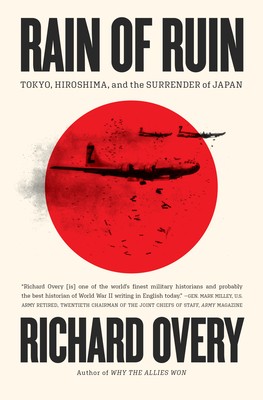
- We will send in 10–14 business days.
- Author: Richard Overy
- Publisher: W. W. Norton & Company
- ISBN-10: 1324105305
- ISBN-13: 9781324105305
- Format: 14.8 x 21.5 x 2.3 cm, kieti viršeliai
- Language: English
- SAVE -10% with code: EXTRA
Reviews
Description
A leading military historian examines the US incendiary and atomic attacks on Japan’s cities, and their impact on the war’s end.In 1945, US air attacks in Japan killed 300,000 civilians in three hours of night bombing and two nuclear strikes. The firebombing of Tokyo in March burned almost the entire city, killed some 85,000 residents, and left more than 1 million homeless. The atomic blast in Hiroshima in August killed some 119,000 civilians and 20,000 soldiers. After a second nuclear attack days later in Nagasaki and a declaration of war by the Soviet Union, Japan accepted defeat.
Drawing on his expertise in the war and its bombing campaigns, Richard Overy delivers a precise recounting of these aerial attacks, especially their impact on civilians, and a balanced assessment of how and why they occurred. Astute on Allied decision-making, Overy notably explores the factional infighting within the Japanese leadership and the decisive role played by the emperor, Hirohito. The war’s endgame required both sides to bridge a cultural divide on surrender.
EXTRA 10 % discount with code: EXTRA
The promotion ends in 23d.18:11:33
The discount code is valid when purchasing from 10 €. Discounts do not stack.
- Author: Richard Overy
- Publisher: W. W. Norton & Company
- ISBN-10: 1324105305
- ISBN-13: 9781324105305
- Format: 14.8 x 21.5 x 2.3 cm, kieti viršeliai
- Language: English English
In 1945, US air attacks in Japan killed 300,000 civilians in three hours of night bombing and two nuclear strikes. The firebombing of Tokyo in March burned almost the entire city, killed some 85,000 residents, and left more than 1 million homeless. The atomic blast in Hiroshima in August killed some 119,000 civilians and 20,000 soldiers. After a second nuclear attack days later in Nagasaki and a declaration of war by the Soviet Union, Japan accepted defeat.
Drawing on his expertise in the war and its bombing campaigns, Richard Overy delivers a precise recounting of these aerial attacks, especially their impact on civilians, and a balanced assessment of how and why they occurred. Astute on Allied decision-making, Overy notably explores the factional infighting within the Japanese leadership and the decisive role played by the emperor, Hirohito. The war’s endgame required both sides to bridge a cultural divide on surrender.


Reviews